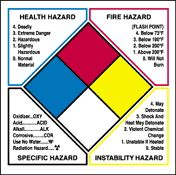 |
 |
| MSDS Topics |
Free Sites | FAQ's | Regulations | Glossary | Software | Suppliers |
| Books | Forum | Poll | Fun stuff | Quiz | Store | |
| MSDS and safety supplies | Search ALL our MSDS info | |||||
 | |||
 |
 |
 |
|
| Title: 08/15/1991 - Hazard Communication and Consumer Products. | |
| Record Type: Interpretation | Standard Number: 1910.1200 |
August 15, 1991
MEMORANDUM FOR: BYRON R. CHADWICK, REGIONAL ADMINISTRATOR
THROUGH: LEO CAREY, DIRECTOR, OFFICE OF FIELD PROGRAMS
FROM: PATRICIA K. CLARK, DIRECTOR, DIRECTORATE OF COMPLIANCE PROGRAMS
SUBJECT: Hazard Communication and Consumer Products
This is in response to your memorandum of May 15 requesting clarification of the application of 29 CFR 1910.1200 to retail establishments which use consumer products for cleaning purposes. This is also in follow-up to several telephone conversations between our staff members on the specific case involved, Safeway, Inc., Store #914, for which a hearing date of August 13 has been set.
|
Your memo requested National Office guidance regarding citation strategy and litigation priorities for violations of consumer product use in a workplace which is not specifically exempted under 1910.1200(b)(6)(vii), i.e., employee use of consumer products which is of a greater frequency and duration than normal consumer use. The performance-oriented nature of the Hazard Communication Standard (HCS) makes it difficult to draw clear, exacting lines for the number of times a consumer product can be used in a workplace before the provisions of the rule apply. However, where an employer is uncertain whether the duration and frequency of exposure to these products is comparable to that of a consumer, he or she should "obtain or develop the MSDS and make it available to employees" (see 52 FR, pg. 31862, August 24, 1987). It is the employer's responsibility to assess his workers' exposures and determine if and when the requirements of the standard apply.
|  Warn your employees about workplace hazards and policies with signs, training materials and more from Safety Emporium. |
 Communicate workplace hazards with handy labels from Safety Emporium. |
It is important to note that the use of consumer products can be hazardous. The fact that a product is labeled in accordance with the provisions of the Consumer Product Safety Act and exempt from OSHA HCS labeling,does not render that product "safe" to use by workers. This is especially pertinent when, as a condition of employment, an employee must utilize a (hazardous) consumer product with a greater frequency and resultant greater duration of exposure than what is typical of a normal consumer or household use. In these situations, the employee has a "right to know" about the hazards of the chemicals he or she is expected to work with and therefore is exposed to. This is the obvious intent of the standard with regard to workplace consumer product exposure. We have been advised by the Solicitor's Office that in cases involving employee workplace exposures to hazardous consumer products, the employer has the initial burden of proving that the product is used in its workplace in a manner contemplated by the exemption language of 1910.1200(b)(6)(vii). That is, the employer must demonstrate that the consumer product is used by employees in the same manner as normal consumer use and that the duration and frequency of exposure is not greater than that experienced by the general public.
|
While we agree that clear lines delineating when the HCS applies and when it would not apply may be difficult to define for all workplace situations and depends on specific workplace conditions, the intent of the HCS, to provide employees information on hazardous chemicals they work with, is clear.
We hope this discussion will be useful to you in this pending case and in future situations.
The official, public domain, OSHA version of this document is available at http://www.osha.gov/pls/oshaweb/owadisp.show_document?p_table=INTERPRETATIONS&p_id=20364&p_text_version=FALSE